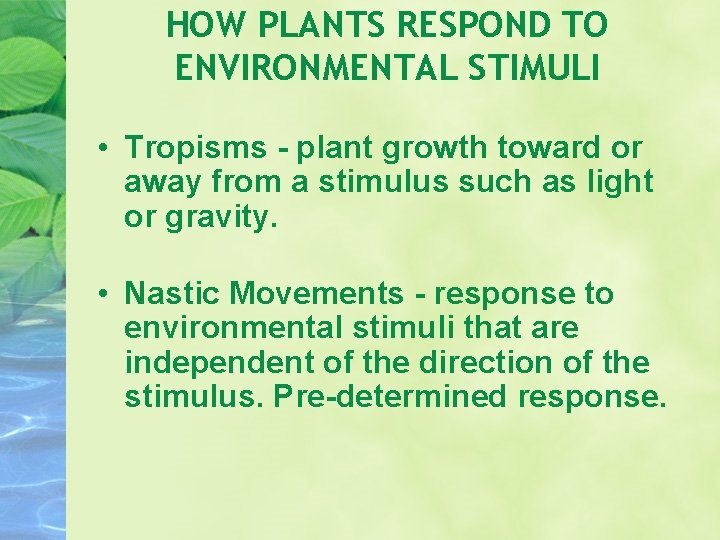Plant Irritability
Plants do respond to a stimulus, this is referred to as plant irritability or plant movement.
There are different kinds of plant movements depending on the plant’s nature, the stimulus, and other conditions.
When plants respond to internal stimuli, it’s called spontaneous movements, while those in response to external stimuli are known as induced, or irritable movements.
Plant Response to External Stimuli
The movement of plants in response to an external stimulus is regarded as induced movement, and there are 3 types of this kind of movement, which include nastic, tropic, and tactic movements, however, the main types of induced movements of plants are nastic and tropic movements.
What are Nastic movements in Plants?
Nastic movements of plants are non-directional movements, made by a part of a stationary plant in response to an external stimulus which is usually described as diffuse.
Examples of Nastic Movements
The closing up of the leaves of a Mimosa plant on being touched is an example of nastic movement in plants.
Another example of a plant response to an external stimulus is the closing up of the lid of a pitcher plant on the entry of an insect.
Also, the sleeping movements of some compound leaves such as those of the flamboyant plant in response to low light intensity and temperature are examples of the responses shown by parts of certain plants to external stimuli.
How do Nastic Movements Occur?
A Nastic movement may be carried out in different ways.
The folding of the leaves of certain plants, for example, the Mimosa, is brought about by changes in the water content of the cells.
When the water content falls, the loss of water from the cells into the large inter-cellular spaces occurs.
Consequently, the cells shrink and the leaves fold up.
On the other hand, when the water content rises, the cells become turgid and the leaves resume their original upright positions.
Tropic Movements in Plants
When a fixed part of a stationary plant moves in response to a stimulus, the reaction is described as a tropism or a tropic movement.
The stimulus is usually applied in one direction and the response is also made in one definite direction.
The response may be towards the stimulus (positive) or away from it (negative). The stimulus is, therefore, unilateral (from one direction) and the response is directional.
Tropisms are growth movements that take place at a very slow pace. The growth movement is caused by an increased or decreased rate of growth on the side of the organ which is under the influence of the stimulus, for the opposite side.
This results in a growth curvature. Growth curvatures usually occur when the outer surface of a root touches an object such as a large stone.
In response to the stimulus of touch, the cells of the root which come in contact with the stimulus grow more rapidly than those on the other side, as a result of which the root turns away from the object.
Thus, a negative tropic curvature occurs when the plant organ grows more rapidly than those on the other side, as a result of which the root turns away from the object.
Moreso, a negative tropic curvature occurs when the plant organ grows more rapidly on the side nearer the stimulus so that it bends away from the stimulus.
In the case of positive tropic curvature, the side of the organ further from the stimulus grows more rapidly so that the organ bends towards the stimulus.
Tactic Movements in Plants
When a whole organism moves from one place to another in response to external stimuli such as light, gravity, water, and certain chemicals, it is said to exhibit a tactic movement or taxis.
Chlamydomonas and Euglena show tactic movements. Usually, motile plants swim towards the light.
Such a movement is described as phototactic. A movement in response to the presence of a certain chemical in the movement is described as chemotactic.
The male gametes of seaweeds are said to exhibit a chemotactic response when they are attracted by some chemicals secreted by the female sex organs and swim towards a stimulus are said to show a positive response, while those that move away from a stimulus are said to show negative response.
Therefore, the source or direction of the stimulus has a direct relationship to the direction of movement of the organism. This type of response to the stimulus is said to be directional.
